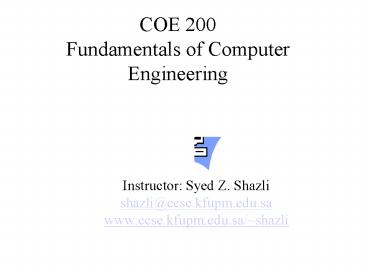COE 200 Fundamentals of Computer Engineering PowerPoint PPT Presentation
Title: COE 200 Fundamentals of Computer Engineering
1
COE 200Fundamentals of Computer Engineering
- Instructor Syed Z. Shazli
- shazli_at_ccse.kfupm.edu.sa
- www.ccse.kfupm.edu.sa/shazli
2
What we will cover
- Introduction
- Boolean algebra and switching theory
- Function minimization
- Combinational circuit design analysis
- Sequential circuit design analysis
- Design of flip-flops, registers, counters etc
- Memory and Programmable Logic Devices
3
Course Website
- Go to webcourses.kfupm.edu.sa
- Enter your login and password
- All the assignments will be posted at this
website - We may also have some online quizzes
- Discussion group and mailing list are present on
the website.
You must check the website regularly
4
Office Hours
- Sat 1000-1100
- Sun 1000-1100
- Mon 1000-1100
- Temporary Location 23-057 Ph 1450
5
Textbook
- Morris Mano and Charles Kime, Logic and Computer
Design Fundamentals,Updated Second Edition,
Prentice Hall International, 2000
6
Grading Policy
- Laboratory 20
- Homeworks Quizzes 15
- Major Exam I 15
- Major Exam II 20
- Final 30
- Some points may be deducted for unexcused absences
7
Grading Policy
- There will be a COMMON PART in each major and the
final which will account for at most 40 of the
exam grade. - WHY?
- To ensure fairness between sections and get a
common average for all sections
8
Assignments
- Will be posted on the course website.
- One week will be given to complete each
assignment. - Will be collected on the designated dates.
- Solutions will be given in the next class.
- No submissions will be acceptable after the
solutions have been discussed
9
Quizzes
- Expect a quiz EVERY SATURDAY
- Quiz will cover material from the last three
lectures - There may be some online quizzes as well
10
Policy statement on Collaboration
- EVERY STUDENT MUST READ (AND FOLLOW) THIS
STATEMENT AT THE COURSE WEBSITE
11
Tentative Exam Dates
- Major Exam I Sun March 10, 2002
- Major Exam II Sat April 13, 2002
- Final TBA
12
Helpful Hints
- Read the textbook.
- Talk to each other.
- Talk to me.
13
Information
- Data -gt Information -gt Knowledge -gt Understanding
- A representation of knowledge
- Knowledge of a song vs. representation
- Can represent in two ways
- analog
- digital
- Digital is better
- computers manipulate digital information
- infinitely replicable
- networks can move bits efficiently
14
Information
- Common
- books
- bills
- CDs
- We can do better if we represent information as
bits - This is the heart of the Digital Revolution
- convert information as atoms to information as
bits - use networks to move bits around instead of atoms
- (What industries are affected?)
15
What do we need?
- Ways to represent all types of information as
bits - Ways to move lots of bits everywhere, cheaply,
and with quality of service
16
Motivation
- Electronics an increasing part of our lives
- Computers the Internet
- Car electronics
- Robots
- Electrical Appliances
- Telephones
- Class covers digital logic design implementation
17
Example Car Electronics
- Brake Light (foot brake, parking brake)
- High-beam indicator (lights, high beam selected)
18
Example Car Electronics (cont.)
- Seat Belt Light (driver belt in)
- Seat Belt Light (driver belt in, passenger belt
in, passenger present)
19
Digital vs. Analog
Analog values vary over a broad range
continuously
Digital only assumes discrete values
20
Advantages of Digital Circuits
- Analog systems slight error in input yields
large error in output - Digital systems more accurate and reliable
- Readily available as self-contained, easy to
cascade building blocks - Computers use digital circuits internally
- Interface circuits (i.e., sensors actuators)
often analog
21
Binary/Boolean Logic
Two discrete values (TTL) yes, on, 5
volts, TRUE, "1" no, off, 0 volts, FALSE, "0"
Advantage of binary systems rigorous
mathematical foundation based on logic
both the door must be open and the car running
before I can back out
IF the garage door is open AND the car is
running THEN the car can be backed out of the
garage
IF passenger is in the car AND passenger belt is
in AND driver belt is in THEN we can turn off the
fasten seat belt light
the three preconditions must be true to imply the
conclusion
22
Things to do
- Review from your class notes what we discussed
today. - Number Systems
- Binary, octal and hexadecimal
- Read Section 1.2 of the textbook before coming to
the class

